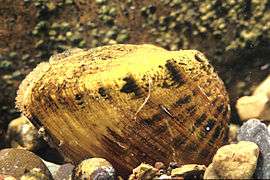Epioblasma
| Epioblasma | |
|---|---|
 | |
| Epioblasma brevidens | |
| Scientific classification | |
| Kingdom: | Animalia |
| Phylum: | Mollusca |
| Class: | Bivalvia |
| Order: | Unionoida |
| Family: | Unionidae |
| Tribe: | Lampsilini |
| Genus: | Epioblasma Rafinesque, 1831 |
Epioblasma is a genus of freshwater mussels, aquatic bivalve mollusks in the family Unionidae, the river mussels. Most of the species in this genus have been lost in modern times, and the entire genus is threatened with the possibility of extinction. The genera has also been identified as Dysnomia.
Reproduction
All Unionidae are known to use the gills, fins, or skin of a host fish for nutrients during the larval glochidia stage. It was discovered in 2004 that female Epioblasma in the subgenus Torulosa transfer their parasitic larvae to the host fish by snapping onto the head of the fish and pumping the larvae into the host fish's gills. While using bait to lure host fish towards the larvae is common in the Unionidae family, this was the first time that "fish snapping" behavior had been observed. Examination of other species within the Epioblasma genus may further reveal unusual reproductive mechanisms.[1]
Species within the genus Epioblasma
- Sugarspoon, Epioblasma arcaeformis
- Angled riffleshell, Epioblasma biemarginata
- Cumberlandian combshell, Epioblasma brevidens
- Oyster mussel, Epioblasma capsaeformis
- Cincinnati Riffleshell, Epioblasma cincinnatiensis
- Leafshell, Epioblasma flexuosa
- Epioblasma florentina
- Curtis pearlymussel, Epioblasma florentina curtisii
- Yellow Blossom, Epioblasma florentina florentina
- Tan riffleshell, Epioblasma florentina walkeri
- Acornshell, Epioblasma haysiana
- Narrow catspaw, Epioblasma lenior
- Forkshell, Epioblasma lewisii
- Upland combshell, Epioblasma metastriata
- Epioblasma obliquata
- Purple catspaw, Epioblasma obliquata obliquata
- White catspaw, Epioblasma obliquata perobliqua
- Southern acornshell, Epioblasma othcaloogensis
- Southern combshell, Epioblasma penita
- Round combshell, Epioblasma personata
- Tennessee riffleshell, Epioblasma propinqua
- Wabash riffleshell, Epioblasma sampsonii
- Cumberland leafshell, Epioblasma stewardsonii
- Epioblasma torulosa
- Green blossom, Epioblasma torulosa gubernaculum
- Northern riffleshell, Epioblasma torulosa rangiana
- Tubercled blossom, Epioblasma torulosa torulosa
- Snuffbox, Epioblasma triquetra
- Turgid riffle shell, Epioblasma turgidula
Conservation status
This entire genus is imperiled. In this genus, 15 species or subspecies are believed to be extinct. Of those remaining, all but one are federally protected species. Only Epioblasma triquetra does not have federal protection at this time, but is considered endangered or threatened on the state level in most of the states within its range.
This group of freshwater mussels is threatened primarily by habitat alteration as are other freshwater mussels. Dams, erosion, and pollution appear to be the primarily threats. Some workers recognize additional species not currently on the official list of recognized species.


